My
List |
Addition Date
|
Target
|
Mission
|
Instrument
|
Size
|

|
2018-03-06 |
Sol (our sun)
|
SDO
|
Atmosphere Imaging Assembly
|
1800x1653x3 |

|
-
PIA22260:
-
Small Bursts
Full Resolution:
TIFF
(4.352 MB)
JPEG
(141.5 kB)
|

|
2018-03-19 |
Sol (our sun)
|
SDO
|
Atmosphere Imaging Assembly
|
1708x1620x3 |

|
-
PIA22345:
-
Elongated Coronal Hole

Full Resolution:
TIFF
(3.231 MB)
JPEG
(125.5 kB)
|

|
2018-04-02 |
Sol (our sun)
|
SDO
|
Atmosphere Imaging Assembly
|
1800x1800x3 |

|
-
PIA22360:
-
Wavelength Comparisons

Full Resolution:
TIFF
(5.55 MB)
JPEG
(192.7 kB)
|

|
2018-04-09 |
Sol (our sun)
|
SDO
|
Atmosphere Imaging Assembly
|
1800x1662x3 |

|
-
PIA22411:
-
Wavelength Comparisons

Full Resolution:
TIFF
(5.735 MB)
JPEG
(162.3 kB)
|

|
2018-04-20 |
Sol (our sun)
|
SDO
|
Atmosphere Imaging Assembly
|
1473x1473x3 |

|
-
PIA06676:
-
Small but Dynamic Active Region

Full Resolution:
TIFF
(3.662 MB)
JPEG
(131.2 kB)
|

|
2018-04-23 |
Sol (our sun)
|
SDO
|
Atmosphere Imaging Assembly
|
1500x1493x3 |
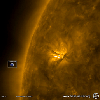
|
-
PIA22430:
-
Active Region Coming Around the Bend

Full Resolution:
TIFF
(3.819 MB)
JPEG
(114.4 kB)
|

|
2018-05-01 |
Sol (our sun)
|
SDO
|
Atmosphere Imaging Assembly
|
1650x1650x3 |

|
-
PIA22449:
-
Tangled Up in Blue

Full Resolution:
TIFF
(6.549 MB)
JPEG
(427.3 kB)
|

|
2018-05-08 |
Sol (our sun)
|
SDO
|
Atmosphere Imaging Assembly
|
1641x1641x3 |
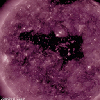
|
-
PIA00624:
-
Coronal Hole Facing Earth

Full Resolution:
TIFF
(6.335 MB)
JPEG
(299.4 kB)
|

|
2018-05-15 |
Sol (our sun)
|
SDO
|
Atmosphere Imaging Assembly
|
1500x1332x3 |

|
-
PIA00577:
-
Coronal Hole Facing Earth

Full Resolution:
TIFF
(3.339 MB)
JPEG
(130 kB)
|

|
2018-05-22 |
Sol (our sun)
|
SDO
|
Atmosphere Imaging Assembly
|
1500x1500x3 |
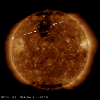
|
-
PIA00575:
-
Coronal Hole Rotating Towards Us

Full Resolution:
TIFF
(3.548 MB)
JPEG
(125 kB)
|

|
2018-05-29 |
Sol (our sun)
|
SDO
|
Atmosphere Imaging Assembly
|
1924x1794x3 |

|
-
PIA22461:
-
New Active Region Sputtering with Small Flares

Full Resolution:
TIFF
(7.438 MB)
JPEG
(293.7 kB)
|

|
2018-06-04 |
Sol (our sun)
|
SDO
|
Atmosphere Imaging Assembly
|
1788x1651x3 |

|
-
PIA22475:
-
Dynamic Looping Action

Full Resolution:
TIFF
(4.859 MB)
JPEG
(188 kB)
|

|
2018-06-11 |
Sol (our sun)
|
SDO
|
Atmosphere Imaging Assembly
|
1425x1425x3 |

|
-
PIA22508:
-
Ballet of Loops

Full Resolution:
TIFF
(3.74 MB)
JPEG
(131 kB)
|

|
2018-06-26 |
Sol (our sun)
|
SDO
|
Atmosphere Imaging Assembly
|
1800x1567x3 |

|
-
PIA22537:
-
Evolving Prominence

Full Resolution:
TIFF
(3.348 MB)
JPEG
(199.1 kB)
|

|
2018-07-05 |
Sol (our sun)
|
SDO
|
Atmosphere Imaging Assembly
|
1794x1632x3 |

|
-
PIA22582:
-
Rambunctious Active Region

Full Resolution:
TIFF
(4.548 MB)
JPEG
(173.5 kB)
|

|
2018-07-17 |
Sol (our sun)
|
SDO
|
Atmosphere Imaging Assembly
|
1770x1632x3 |

|
-
PIA22589:
-
Festoons of Loops

Full Resolution:
TIFF
(4.784 MB)
JPEG
(157.8 kB)
|

|
2018-07-24 |
Sol (our sun)
|
SDO
|
Atmosphere Imaging Assembly
|
1669x1669x3 |

|
-
PIA22645:
-
Detailed Loops Above an Active Region

Full Resolution:
TIFF
(4.775 MB)
JPEG
(171.4 kB)
|

|
2018-07-31 |
Sol (our sun)
|
SDO
|
Atmosphere Imaging Assembly
|
1740x1635x1 |

|
-
PIA22646:
-
An Almost Spotless Record

Full Resolution:
TIFF
(1.411 MB)
JPEG
(157.9 kB)
|

|
2018-08-07 |
Sol (our sun)
|
SDO
|
Atmosphere Imaging Assembly
|
1687x1684x3 |

|
-
PIA22661:
-
Twisting Prominences

Full Resolution:
TIFF
(3.843 MB)
JPEG
(231.7 kB)
|

|
2018-08-14 |
Sol (our sun)
|
SDO
|
Atmosphere Imaging Assembly
|
1800x1800x3 |

|
-
PIA22662:
-
Magnetic Field Portrayed

Full Resolution:
TIFF
(8.707 MB)
JPEG
(757.2 kB)
|

|
2018-08-20 |
Sol (our sun)
|
SDO
|
Atmosphere Imaging Assembly
|
1498x1500x3 |

|
-
PIA22673:
-
Twisting Outburst

Full Resolution:
TIFF
(3.898 MB)
JPEG
(196.1 kB)
|

|
2018-09-03 |
Sol (our sun)
|
SDO
|
Atmosphere Imaging Assembly
|
1780x1750x3 |
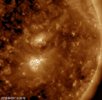
|
-
PIA22680:
-
New Active Region Grows Up

Full Resolution:
TIFF
(6.915 MB)
JPEG
(212.3 kB)
|

|
2018-09-17 |
Sol (our sun)
|
SDO
|
Atmosphere Imaging Assembly
|
1500x1500x3 |
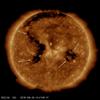
|
-
PIA22722:
-
Emerging Coronal Hole

Full Resolution:
TIFF
(3.545 MB)
JPEG
(135.6 kB)
|

|
2018-09-17 |
Sol (our sun)
|
SDO
|
Atmosphere Imaging Assembly
|
1800x1800x3 |

|
-
PIA22723:
-
Double Lunar Transit

Full Resolution:
TIFF
(2.063 MB)
JPEG
(142 kB)
|

|
2018-09-24 |
Sol (our sun)
|
SDO
|
Atmosphere Imaging Assembly
|
1800x1800x3 |

|
-
PIA22724:
-
Two Wavelengths, Two Different Images

Full Resolution:
TIFF
(5.585 MB)
JPEG
(262.9 kB)
|

|
2018-10-17 |
Sol (our sun)
|
SDO
|
Atmosphere Imaging Assembly
|
1668x1668x3 |

|
-
PIA18139:
-
Sole Active Region in Profile

Full Resolution:
TIFF
(4.272 MB)
JPEG
(150.1 kB)
|

|
2018-10-29 |
Sol (our sun)
|
SDO
|
Atmosphere Imaging Assembly
|
1770x1765x3 |

|
-
PIA18140:
-
Eruptive Prominence

Full Resolution:
TIFF
(3.695 MB)
JPEG
(240.5 kB)
|

|
2018-11-12 |
Sol (our sun)
|
SDO
|
Atmosphere Imaging Assembly
|
1445x1445x3 |

|
-
PIA18141:
-
Central Coronal Hole

Full Resolution:
TIFF
(4.566 MB)
JPEG
(155.4 kB)
|

|
2018-11-14 |
Sol (our sun)
|
SDO
|
Atmosphere Imaging Assembly
|
1628x1587x3 |

|
-
PIA18142:
-
SDO Observes a Partial Lunar Eclipse

Full Resolution:
TIFF
(3.473 MB)
JPEG
(139.1 kB)
|

|
2018-11-19 |
Sol (our sun)
|
SDO
|
Atmosphere Imaging Assembly
|
1800x1800x3 |

|
-
PIA18143:
-
Opposing Solar Prominences

Full Resolution:
TIFF
(5.168 MB)
JPEG
(372.5 kB)
|

|
2018-12-05 |
Sol (our sun)
|
SDO
|
Atmosphere Imaging Assembly
|
1500x1500x3 |

|
-
PIA18144:
-
Reappearing Coronal Hole

Full Resolution:
TIFF
(4.192 MB)
JPEG
(145.1 kB)
|

|
2018-12-11 |
Sol (our sun)
|
SDO
|
Atmosphere Imaging Assembly
|
1650x1650x3 |

|
-
PIA21211:
-
Solar Active Region's Cameo Appearance

Full Resolution:
TIFF
(4.752 MB)
JPEG
(146 kB)
|

|
2018-12-24 |
Sol (our sun)
|
SDO
|
Atmosphere Imaging Assembly
|
1800x1800x3 |
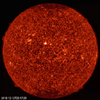
|
-
PIA21212:
-
Small Prominences

Full Resolution:
TIFF
(5.751 MB)
JPEG
(400 kB)
|

|
2019-02-19 |
Sol (our sun)
|
SDO
|
Atmosphere Imaging Assembly
|
1650x1540x3 |

|
-
PIA21213:
-
Spring 2019 Eclipse Season Arrives

Full Resolution:
TIFF
(2.94 MB)
JPEG
(152.9 kB)
|

|
2019-03-04 |
Sol (our sun)
|
SDO
|
Atmosphere Imaging Assembly
|
1520x1500x3 |

|
-
PIA21218:
-
Spotless February

Full Resolution:
TIFF
(1.689 MB)
JPEG
(190.5 kB)
|

|
2019-03-11 |
Sol (our sun)
|
SDO
|
Atmosphere Imaging Assembly
|
1500x1414x3 |

|
-
PIA21905:
-
Criss-Crossing Lunar Transit

Full Resolution:
TIFF
(2.274 MB)
JPEG
(92.56 kB)
|

|
2014-12-05 |
|
Spitzer Space Telescope
|
Canada France Hawaii Telescope
IRAC
Very Large Array (VLA)
|
3615x3500x3 |
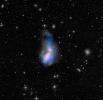
|
-
PIA18902:
-
A Flood of Gas
Full Resolution:
TIFF
(14.47 MB)
JPEG
(2.111 MB)
|

|
2019-09-12 |
|
|
Canada-France-Hawaii Telescope
|
705x645x1 |

|
-
PIA23462:
-
Comet C/2019 Q4
Full Resolution:
TIFF
(455.4 kB)
JPEG
(131.8 kB)
|

|
2014-12-11 |
|
|
Chandra X-ray Observatory
Hubble Space Telescope
Spitzer Space Telescope
|
3600x1742x3 |

|
-
PIA18903:
-
Galactic Gathering Gives Impressive Light Display
Full Resolution:
TIFF
(18.82 MB)
JPEG
(698.6 kB)
|

|
2004-10-06 |
|
Chandra X-ray Observatory
|
Chandra X-ray Telescope
|
2400x2400x3 |
![The images indicate that the bubble of gas that makes up the supernova remnant appears different in various types of light. Chandra reveals the hottest gas [colored blue and colored green], which radiates in X-rays.](/thumb/PIA06908.jpg)
|
-
PIA06908:
-
Kepler's Supernova Remnant: A View from Chandra X-Ray Observatory
Full Resolution:
TIFF
(8.168 MB)
JPEG
(288.1 kB)
|

|
2007-10-25 |
|
Chandra X-ray Observatory
|
Chandra X-ray Telescope
|
5100x2550x3 |

|
-
PIA10092:
-
Stacks of Light
Full Resolution:
TIFF
(39.02 MB)
JPEG
(385.4 kB)
|

|
2017-01-24 |
NGC 7331
|
Chandra X-ray Observatory
SDSS
|
Chandra X-ray Telescope
|
864x864x3 |

|
-
PIA21088:
-
Supernova SN 2014C (Optical and X-Ray)
Full Resolution:
TIFF
(1.854 MB)
JPEG
(82.92 kB)
|

|
2017-01-24 |
NGC 7331
|
Chandra X-ray Observatory
|
Chandra X-ray Telescope
|
1800x1800x3 |

|
-
PIA21089:
-
Supernova SN 2014C (X-ray)
Full Resolution:
TIFF
(4.854 MB)
JPEG
(71.01 kB)
|

|
2006-01-11 |
Cartwheel Galaxy
|
Galaxy Evolution Explorer (GALEX)
Hubble Space Telescope
Spitzer Space Telescope
|
Chandra X-ray Telescope
GALEX Telescope
Infrared Array Camera (IRAC)
Visible Light
|
1500x1500x3 |

|
-
PIA03296:
-
A Stellar Ripple
Full Resolution:
TIFF
(6.762 MB)
JPEG
(201.2 kB)
|

|
2004-10-06 |
|
Hubble Space Telescope
Spitzer Space Telescope
|
Chandra X-ray Telescope
Hubble Space Telescope
Spitzer Space Telescope
|
750x750x3 |
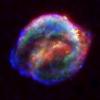
|
-
PIA06907:
-
Three Great Eyes on Kepler's Supernova
Remnant
Full Resolution:
TIFF
(1.453 MB)
JPEG
(33.78 kB)
|

|
2007-06-13 |
N132D
|
Spitzer Space Telescope
|
Chandra X-ray Telescope
Infrared Array Camera (IRAC)
Multiband Imaging Photometer (MIPS)
|
1806x1200x3 |
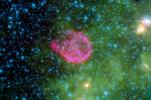
|
-
PIA09604:
-
A Supernova's Shockwaves
Full Resolution:
TIFF
(6.511 MB)
JPEG
(206.6 kB)
|

|
2006-04-24 |
M82 Galaxy
|
Hubble Space Telescope
Spitzer Space Telescope
|
Chandra X-ray Telescope
Infrared Array Camera (IRAC)
Visible Light
|
640x480x3 |

|
-
PIA08093:
-
Great Observatories Present Rainbow of a Galaxy

Full Resolution:
TIFF
(45.01 MB)
JPEG
(799.8 kB)
|

|
2014-10-08 |
|
NuSTAR
|
Chandra X-ray Telescope
Hubble Space Telescope
|
1200x675x3 |

|
-
PIA18840:
-
Galaxy in Different Lights
Full Resolution:
TIFF
(2.431 MB)
JPEG
(58.14 kB)
|

|
2008-10-06 |
NGC 6193
|
Chandra X-ray Observatory
Spitzer Space Telescope
|
Chandra X-ray Telescope
IRAC
|
3300x3135x3 |

|
-
PIA11226:
-
RCW 108: Massive Young Stars Trigger Stellar Birth
Full Resolution:
TIFF
(31.04 MB)
JPEG
(524.6 kB)
|

|
2009-01-06 |
Cassiopeia A
|
Chandra X-ray Observatory
Spitzer Space Telescope
|
Chandra X-ray Telescope
IRAC
|
719x479x3 |

|
-
PIA11748:
-
Supernova Remnant in 3-D

Full Resolution:
TIFF
(1.035 MB)
JPEG
(36.78 kB)
|

|
2009-08-12 |
Cepheus B
|
Chandra X-ray Observatory
Spitzer Space Telescope
|
Chandra X-ray Telescope
IRAC
|
2749x3600x3 |

|
-
PIA12169:
-
Trigger-Happy Cloud
Full Resolution:
TIFF
(29.69 MB)
JPEG
(402.1 kB)
|

|
2010-03-29 |
|
Chandra X-ray Observatory
Spitzer Space Telescope
|
Chandra X-ray Telescope
IRAC
|
3600x3547x3 |

|
-
PIA12982:
-
Dusty Dead Star
Full Resolution:
TIFF
(38.31 MB)
JPEG
(303.8 kB)
|

|
2011-09-28 |
NGC 281
|
Chandra X-ray Observatory
Spitzer Space Telescope
|
Chandra X-ray Telescope
IRAC
|
3600x2719x3 |

|
-
PIA14731:
-
The 'Pacman Nebula'
Full Resolution:
TIFF
(29.37 MB)
JPEG
(797.6 kB)
|

|
2011-11-16 |
|
Chandra X-ray Observatory
Spitzer Space Telescope
|
Chandra X-ray Telescope
IRAC
|
3600x3069x3 |

|
-
PIA15079:
-
30 Doradus: The Growing Tarantula Within
Full Resolution:
TIFF
(33.15 MB)
JPEG
(457 kB)
|

|
2016-01-07 |
|
Chandra X-ray Observatory
Herschel Space Observatory
Spitzer Space Telescope
|
Chandra X-ray Telescope
IRAC
|
1719x1718x3 |

|
-
PIA20063:
-
Galaxy Cluster IDCS J1426
Full Resolution:
TIFF
(7.301 MB)
JPEG
(258.9 kB)
|

|
2009-02-10 |
Messier 101
|
Hubble Space Telescope
Spitzer Space Telescope
|
Chandra X-ray Telescope
IRAC
Visible Light
|
7200x7200x3 |

|
-
PIA11797:
-
NASA's Great Observatories Celebrate the International Year of Astronomy
Full Resolution:
TIFF
(155.5 MB)
JPEG
(6.529 MB)
|

|
2013-04-03 |
|
Chandra X-ray Observatory
Hubble Space Telescope
Spitzer Space Telescope
|
Chandra X-ray Telescope
IRAC
Visible-Light
|
3600x3600x3 |

|
-
PIA16884:
-
Taken Under the 'Wing' of the Small Magellanic Cloud
Full Resolution:
TIFF
(38.89 MB)
JPEG
(1.685 MB)
|

|
2011-10-24 |
|
Chandra X-ray Observatory
Spitzer Space Telescope
Wide-field Infrared Survey Explorer (WISE)
|
Chandra X-ray Telescope
IRAC
WISE Telescope
XMM-Newton X-ray
|
2811x2154x3 |
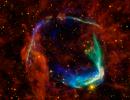
|
-
PIA14872:
-
All Eyes on Oldest Recorded Supernova
Full Resolution:
TIFF
(18.16 MB)
JPEG
(361.1 kB)
|

|
2014-02-19 |
|
Chandra X-ray Observatory
NuSTAR
|
Chandra X-ray Telescope
NuSTAR
|
3000x3000x3 |

|
-
PIA17838:
-
Untangling the Remains of Cassiopeia A
Full Resolution:
TIFF
(27.01 MB)
JPEG
(350.8 kB)
|

|
2014-02-19 |
|
Chandra X-ray Observatory
NuSTAR
|
Chandra X-ray Telescope
NuSTAR
|
3072x1024x3 |

|
-
PIA17839:
-
Adding a New "Color" to Palate of Cassiopeia A Images
Full Resolution:
TIFF
(9.442 MB)
JPEG
(157.2 kB)
|

|
2014-02-19 |
|
Chandra X-ray Observatory
NuSTAR
|
Chandra X-ray Telescope
NuSTAR
|
1024x1024x3 |

|
-
PIA17841:
-
Radioactive Core of a Dead Star
Full Resolution:
TIFF
(3.147 MB)
JPEG
(62.44 kB)
|

|
2014-02-19 |
|
Chandra X-ray Observatory
NuSTAR
|
Chandra X-ray Telescope
NuSTAR
|
2048x1024x3 |

|
-
PIA17842:
-
The Case of Missing Iron in Cassiopeia A
Full Resolution:
TIFF
(6.294 MB)
JPEG
(87.83 kB)
|

|
2014-02-19 |
|
Chandra X-ray Observatory
NuSTAR
|
Chandra X-ray Telescope
NuSTAR
|
3000x2000x3 |

|
-
PIA17844:
-
Evolution of a Supernova
Full Resolution:
TIFF
(18.01 MB)
JPEG
(344.8 kB)
|

|
2014-02-19 |
|
Chandra X-ray Observatory
NuSTAR
|
Chandra X-ray Telescope
NuSTAR
|
3000x2400x3 |

|
-
PIA17846:
-
NuSTAR Data Point to Sloshing Supernovas
Full Resolution:
TIFF
(21.61 MB)
JPEG
(378 kB)
|

|
2016-03-03 |
|
|
CHIMERA
|
1007x1020x3 |

|
-
PIA20347:
-
Versatile Instrument to Scout for Kuiper Belt Objects
Full Resolution:
TIFF
(3.083 MB)
JPEG
(105.7 kB)
|

|
2014-11-06 |
|
CIBER
|
CIBER
|
2248x1328x3 |

|
-
PIA18849:
-
Matching Patterns of Light
Full Resolution:
TIFF
(8.96 MB)
JPEG
(146.3 kB)
|

|
2006-01-17 |
|
Stardust
|
DC-8 Airborne Laboratory
|
2360x1808x3 |

|
-
PIA03668:
-
Stardust Capsule Return
Full Resolution:
TIFF
(12.82 MB)
JPEG
(371 kB)
|

|
2021-03-26 |
Asteroid
|
|
Deep Space Network
|
2999x1300x1 |

|
-
PIA24168:
-
Radar Observations of Asteroid 99942 Apophis
Full Resolution:
TIFF
(1.73 MB)
JPEG
(419.4 kB)
|

|
2021-04-05 |
Asteroid
|
|
Deep Space Network
|
1254x958x1 |

|
-
PIA24561:
-
Goldstone Radar Observations of Asteroid 2001 FO32
Full Resolution:
TIFF
(916.4 kB)
JPEG
(154.5 kB)
|

|
2021-09-03 |
Asteroid
|
Deep Space Network (DSN)
|
Deep Space Network
|
1314x1274x3 |

|
-
PIA24563:
-
The Doppler Spike of Asteroid 2021 PJ1
Full Resolution:
TIFF
(222.2 kB)
JPEG
(126.8 kB)
|

|
2021-09-03 |
Asteroid
|
Deep Space Network (DSN)
|
Deep Space Network
|
2002x1128x3 |

|
-
PIA24564:
-
Radar Reveals the Surface of Asteroid 2016 AJ193
Full Resolution:
TIFF
(1.579 MB)
JPEG
(806.3 kB)
|

|
2022-01-10 |
Asteroid
|
Deep Space Network (DSN)
|
Deep Space Network
|
3093x1963x1 |

|
-
PIA24566:
-
Radar Observations of Asteroid 4660 Nereus
Full Resolution:
TIFF
(4.104 MB)
JPEG
(1.418 MB)
|

|
2022-06-29 |
Asteroid
|
Deep Space Network (DSN)
|
Deep Space Network
|
1587x1137x1 |

|
-
PIA25251:
-
Radar Observations of Near-Earth Asteroid 7335 1989 JA
Full Resolution:
TIFF
(972.3 kB)
JPEG
(398.1 kB)
|

|
2023-02-17 |
Asteroid
|
Deep Space Network (DSN)
|
Deep Space Network
|
3085x2437x1 |

|
-
PIA25259:
-
Radar Observations of Elongated Near-Earth Asteroid 2011 AG5
Full Resolution:
TIFF
(3.87 MB)
JPEG
(1.727 MB)
|

|
2023-04-26 |
Asteroid
|
Deep Space Network (DSN)
|
Deep Space Network
|
2922x1411x1 |

|
-
PIA25834:
-
NASA's Planetary Radar Images Asteroid 2006 HV5
Full Resolution:
TIFF
(2.324 MB)
JPEG
(1.039 MB)
|

|
2024-02-26 |
Asteroid
|
Deep Space Network (DSN)
|
Deep Space Network
|
3410x2222x1 |
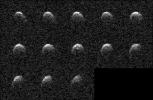
|
-
PIA26149:
-
NASA's Planetary Radar Images Slow-Spinning Asteroid 2008 OS7
Full Resolution:
TIFF
(1.567 MB)
JPEG
(725.4 kB)
|

|
2024-07-03 |
Asteroid
|
Deep Space Network (DSN)
|
Deep Space Network
|
7202x8058x1 |

|
-
PIA26383:
-
Detailed Planetary Radar Observations of Asteroid 2024 MK
Full Resolution:
TIFF
(25.86 MB)
JPEG
(5.619 MB)
|

|
2024-07-03 |
Asteroid
|
Deep Space Network (DSN)
|
Deep Space Network
|
2192x974x1 |

|
-
PIA26384:
-
Goldstone Planetary Radar Observes Binary Asteroid 2011 UL21
Full Resolution:
TIFF
(1.765 MB)
JPEG
(357 kB)
|

|
2024-08-29 |
Asteroid
|
Deep Space Network (DSN)
|
Deep Space Network
|
1474x990x1 |

|
-
PIA26389:
-
Goldstone Planetary Radar Observes Peanut-Shaped Asteroid
Full Resolution:
TIFF
(1.226 MB)
JPEG
(269.2 kB)
|

|
2024-09-17 |
Asteroid
|
Deep Space Network (DSN)
|
Deep Space Network
|
4757x3262x1 |

|
-
PIA26451:
-
NASA's Planetary Radar Spies (Another) Peanut-Shaped Asteroid
Full Resolution:
TIFF
(11.11 MB)
JPEG
(3.026 MB)
|

|
2009-02-18 |
|
Galaxy Evolution Explorer (GALEX)
|
Digitized Sky Survey
|
2766x1977x3 |

|
-
PIA11805:
-
Seeing Baby Dwarf Galaxies
Full Resolution:
TIFF
(16.41 MB)
JPEG
(537.6 kB)
|

|
2001-02-17 |
Sol (our sun)
|
SOHO
|
Extreme Ultraviolet Imaging Telescope
|
2100x2034x3 |

|
-
PIA03149:
-
Handle-shaped Prominence
Full Resolution:
TIFF
(4.315 MB)
JPEG
(409.1 kB)
|

|
2001-02-17 |
Sol (our sun)
|
SOHO
|
Extreme Ultraviolet Imaging Telescope
|
1067x1067x3 |

|
-
PIA03150:
-
Color Composite of Solar Features
Full Resolution:
TIFF
(3.508 MB)
JPEG
(108.6 kB)
|

|
2007-03-07 |
Z Camelopardalis
|
Galaxy Evolution Explorer (GALEX)
|
Far-ultraviolet Detector
|
1800x1800x3 |
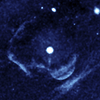
|
-
PIA09219:
-
Ghostly Remnant of an Explosive Past

Full Resolution:
TIFF
(9.735 MB)
JPEG
(153.7 kB)
|

|
2007-03-07 |
Z Camelopardalis
|
Galaxy Evolution Explorer (GALEX)
|
Far-ultraviolet Detector
Near-ultraviolet Detector
|
1800x1800x3 |

|
-
PIA09220:
-
Scene of Multiple Explosions

Full Resolution:
TIFF
(9.735 MB)
JPEG
(851.7 kB)
|

|
2007-06-20 |
NGC 362
|
Galaxy Evolution Explorer (GALEX)
|
Far-ultraviolet Detector
Near-ultraviolet Detector
|
2250x2550x3 |

|
-
PIA09653:
-
Galaxy Evolution Explorer Spies Band of Stars
Full Resolution:
TIFF
(17.23 MB)
JPEG
(705.7 kB)
|

|
2016-08-24 |
|
Wide-field Infrared Survey Explorer (WISE)
|
Fermi Gamma-ray Space Telescope
|
985x739x3 |

|
-
PIA20912:
-
Blazar Artist Concept
Full Resolution:
TIFF
(2.185 MB)
JPEG
(102.4 kB)
|

|
2012-02-13 |
|
Planck
|
Fermi Gamma-ray Space Telescope
Planck LFI-HFI
|
1024x768x3 |

|
-
PIA15229:
-
Galactic Haze seen by Planck and Galactic 'Bubbles' seen by Fermi
Full Resolution:
TIFF
(2.363 MB)
JPEG
(113.3 kB)
|

|
2012-03-29 |
|
SOFIA
|
FORCAST
|
1512x2019x3 |

|
-
PIA15420:
-
NASA's SOFIA Captures Images of the Planetary Nebula M2-9
Full Resolution:
TIFF
(9.175 MB)
JPEG
(78.26 kB)
|

|
2009-06-04 |
Cepheus
|
Dawn
|
Framing Camera
|
1024x1024x1 |

|
-
PIA12066:
-
Star Field in the Constellation Cepheus
Full Resolution:
TIFF
(1.05 MB)
JPEG
(46.93 kB)
|

|
2009-06-04 |
Carina
|
Dawn
|
Framing Camera
|
1647x1635x3 |

|
-
PIA12067:
-
Dawn's Framing Camera Views Carina
Full Resolution:
TIFF
(8.092 MB)
JPEG
(282.3 kB)
|

|
2003-05-28 |
|
Galaxy Evolution Explorer (GALEX)
|
GALEX Telescope
|
534x528x3 |

|
-
PIA04278:
-
GALEX 1st Light Near Ultraviolet -50
Full Resolution:
TIFF
(540.4 kB)
JPEG
(33.53 kB)
|

|
2003-05-28 |
|
Galaxy Evolution Explorer (GALEX)
|
GALEX Telescope
|
1450x1550x3 |

|
-
PIA04279:
-
GALEX 1st Light Near Ultraviolet
Full Resolution:
TIFF
(2.538 MB)
JPEG
(173.2 kB)
|

|
2003-05-28 |
|
Galaxy Evolution Explorer (GALEX)
|
GALEX Telescope
|
1450x1555x3 |

|
-
PIA04280:
-
GALEX 1st Light Far Ultraviolet
Full Resolution:
TIFF
(1.453 MB)
JPEG
(93.59 kB)
|

|
2003-05-28 |
|
Galaxy Evolution Explorer (GALEX)
|
GALEX Telescope
|
534x528x3 |

|
-
PIA04281:
-
GALEX 1st Light Near and Far Ultraviolet -100
Full Resolution:
TIFF
(390.4 kB)
JPEG
(22.84 kB)
|

|
2003-05-28 |
|
Galaxy Evolution Explorer (GALEX)
|
GALEX Telescope
|
2112x1533x3 |
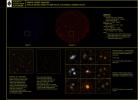
|
-
PIA04282:
-
GALEX 1st Light Compilation
Full Resolution:
TIFF
(2.837 MB)
JPEG
(340.9 kB)
|

|
2003-07-25 |
|
Galaxy Evolution Explorer (GALEX)
|
GALEX Telescope
|
989x1010x3 |

|
-
PIA04623:
-
Galaxy UGC10445
Full Resolution:
TIFF
(1.436 MB)
JPEG
(48.59 kB)
|

|
2003-07-25 |
|
Galaxy Evolution Explorer (GALEX)
|
GALEX Telescope
|
1600x1496x3 |

|
-
PIA04624:
-
Galaxy Centaurus A
Full Resolution:
TIFF
(7.193 MB)
JPEG
(235.1 kB)
|

|
2003-07-25 |
|
Galaxy Evolution Explorer (GALEX)
|
GALEX Telescope
|
795x735x3 |

|
-
PIA04625:
-
Groth Deep Image
Full Resolution:
TIFF
(1.143 MB)
JPEG
(66.32 kB)
|

|
2003-07-25 |
|
Galaxy Evolution Explorer (GALEX)
|
GALEX Telescope
|
796x733x3 |

|
-
PIA04626:
-
Groth Deep Locations Image
Full Resolution:
TIFF
(1.188 MB)
JPEG
(93.39 kB)
|

 Planetary Data System
Planetary Data System




















































![The images indicate that the bubble of gas that makes up the supernova remnant appears different in various types of light. Chandra reveals the hottest gas [colored blue and colored green], which radiates in X-rays.](/thumb/PIA06908.jpg)
































































